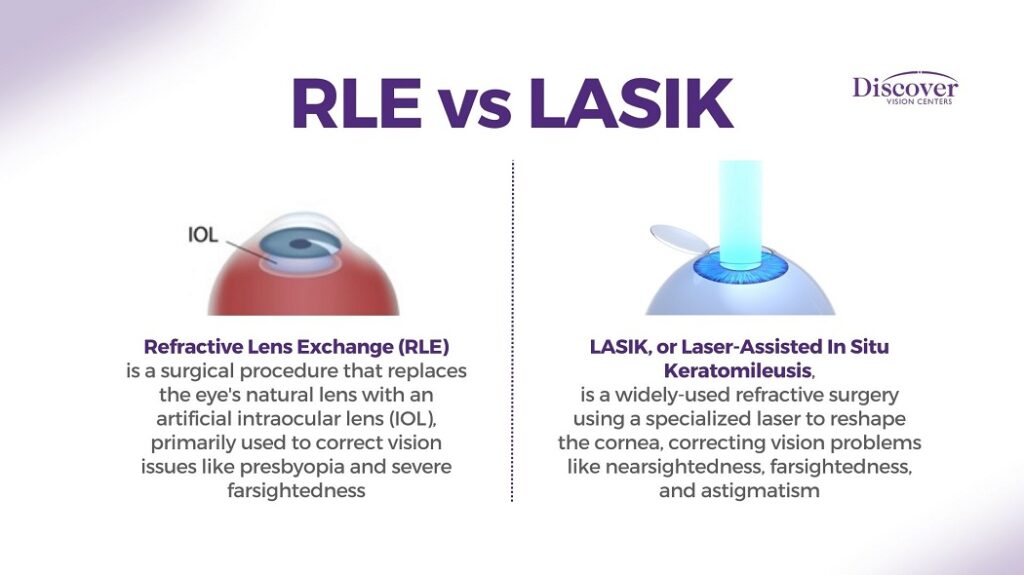
Updated: December 31, 2024

Lens replacement and LASIK are two distinct approaches to vision correction, each with its own set of benefits and considerations. Lens replacement, such as Refractive Lens Exchange (RLE), involves surgically replacing the eye’s natural lens with an artificial intraocular lens (IOL). This is particularly effective for addressing various refractive errors, including cataracts. On the other hand, LASIK (Laser-Assisted In Situ Keratomileusis) is a non-invasive procedure that reshapes the cornea using a laser to correct common refractive issues like nearsightedness, farsightedness, and astigmatism. Choosing between these methods depends on individual factors, preferences, and specific vision correction needs. It should be noted that there are many names for the same procedure with regard to refractive lens exchange. Other names for the same procedure – Refractive Lens Exchange are Refractive Lens Replacement, Clear Lens Exchange, Clear Lens Replacement, Custom Lens Replacement. All of these terms describe the exact same procedure.
Refractive Lens Exchange (RLE) is a transformative surgical approach that enhances vision by replacing the eye’s natural lens with a customized intraocular lens (IOL), addressing refractive errors like nearsightedness, farsightedness, and astigmatism. Beyond refractive corrections, RLE is a comprehensive solution for cataracts. Understanding its advantages, potential limitations, and the ideal candidate profile is crucial for those considering this procedure.
RLE corrects vision by removing the eye’s natural lens and replacing it with a precisely tailored IOL. This not only addresses common vision impairments but also serves to prevent or treat cataracts, making RLE a versatile solution for lasting visual clarity.
The enduring benefits of RLE extend beyond immediate visual correction. Patients often experience a sustained reduction in dependence on glasses or contact lenses, enhancing daily activities. The procedure’s capacity to simultaneously address multiple vision issues, including cataracts, underscores its comprehensive nature. The relatively short recovery period facilitates a swift return to normalcy.
While highly effective, RLE comes with potential limitations and risks. Adverse outcomes, such as infection or transient visual disturbances like halos or glare, may occur. Careful preoperative assessments and patient education are crucial, emphasizing the need for informed decision-making and realistic expectations.

Ideal candidates for RLE often seek a permanent solution to refractive errors, particularly those dealing with age-related vision changes or cataracts. Customization is a hallmark of RLE, allowing for a tailored approach to each patient’s unique circumstances. Thorough consultations with eye care professionals are imperative to assess individual candidacy and ensure optimal outcomes.
Refractive Lens Exchange stands as a dynamic and versatile solution for lasting vision enhancement, offering enduring benefits and addressing a range of vision issues. This comprehensive overview delves into how RLE works, its advantages, potential limitations, and the criteria defining the ideal candidate, providing insight into the transformative potential of this surgical procedure.
Considering LASIK surgery for vision correction is a significant decision that can lead to life-changing improvements in eyesight. LASIK, or Laser-Assisted In Situ Keratomileusis, is a widely acclaimed refractive surgery designed to correct common vision problems such as nearsightedness, farsightedness, and astigmatism. The procedure involves reshaping the cornea using a laser, allowing light to be properly focused onto the retina, resulting in clearer vision. As you explore laser eye surgery, it’s essential to understand the procedure, benefits, considerations, and whether you meet the candidacy criteria.
LASIK is a quick and virtually painless outpatient procedure. It begins with the creation of a thin flap on the cornea, which is then lifted to expose the underlying tissue. The excimer laser is then employed to precisely reshape the cornea tissue based on the patient’s specific vision prescription. Once the cornea is reshaped, the flap is repositioned, and the eye starts the healing process. The entire procedure takes minimal time for both eyes, and many patients notice a significant improvement in their vision immediately.

One of the primary advantages of LASIK is the rapid recovery time, allowing patients to resume their normal activities within a short period. The procedure often eliminates or significantly reduces the need for glasses or contact lenses, providing enhanced convenience. Moreover, LASIK offers a precise and customizable approach to vision correction, and many individuals experience improved vision clarity and a reduction in dependence on corrective eyewear.
While LASIK is a generally safe and effective procedure, it’s important to be aware of potential considerations and risks. Some individuals may experience temporary side effects like dry eyes, glare, or halos, which usually subside during the healing process. In rare cases, more serious complications can occur, underscoring the importance of a thorough preoperative consultation to assess individual factors and manage expectations.
Determining LASIK candidacy involves several factors, including age, overall eye health, and specific vision correction needs. Factors such as presbyopia, which affects near vision and is linked to aging, may influence candidacy. Individuals interested in LASIK should consult with an eye care professional to undergo a comprehensive evaluation to ensure they have good eye health, and are a good candidate in order to achieve a successful and satisfactory outcome.
As you explore the possibilities of LASIK surgery to correct vision, consider the procedure, weigh the benefits, be aware of potential risks, and determine whether you meet the candidacy criteria for this transformative vision correction option. For more information on related topics such as presbyopia correction, eyeglasses, and contact lenses, visit Discover Vision.

Choosing between LASIK (Laser-Assisted In Situ Keratomileusis) and RLE (Refractive Lens Exchange) involves understanding their distinct approaches to vision correction. Let’s explore the key differences in eligibility, suitability, recovery, and healing time.
LASIK primarily addresses refractive errors by reshaping the cornea, making it suitable for individuals with nearsightedness, farsightedness, and astigmatism. RLE, on the other hand, involves replacing the eye’s natural lens with an artificial intraocular lens (IOL). This makes RLE a preferred choice for those with age-related vision changes, cataracts, or individuals seeking a permanent solution to refractive errors. There is a variety of lens technology to meet a patient’s specific visual goals. The eligibility criteria often depend on factors such as overall eye health, prescription stability, and specific visual needs.
LASIK is known for its rapid recovery, with many patients experiencing improved vision within a day or two. The majority can resume normal activities shortly after the procedure. RLE, being a more invasive surgery, may have a slightly longer recovery period. Patients often notice visual improvements within a week, with a full recovery taking a few weeks. While both procedures have relatively short downtime, the choice between LASIK and RLE may be influenced by the urgency of visual correction and natural aging changes.
In summary, the decision between LASIK and RLE hinges on factors like the nature of refractive errors and the presence of cataracts. Understanding these key differences is crucial for making an informed choice in pursuing the most suitable vision correction procedure.
| LASIK | RLE (Refractive Lens Exchange) | |
|---|---|---|
| Corrective Uses |
|
|
| Procedure Duration | Outpatient, approximately 15 minutes per eye | Outpatient, approximately 20 to 30 minutes per eye |
| Recovery Time | Typically 2 to 7 days | Normal activities within 2 to 7 days; full adaptation takes 6 to 12 weeks |
| Contraindications |
|
|
Deciding between lens replacement surgery (RLE) and LASIK for vision correction involves considering factors like refractive needs, age-related changes, and recovery. Discover Vision offers comprehensive insights into these procedures, aiding individuals in making informed choices for optimal vision outcomes. For personalized advice tailored to your unique needs, schedule a consultation with Discover Vision at their location. Choose the vision correction method that aligns with your preferences and lifestyle for clearer, sharper vision.